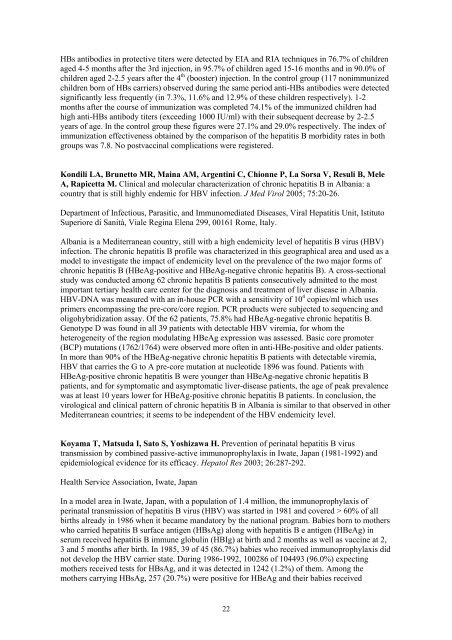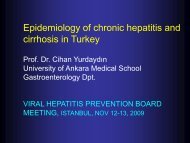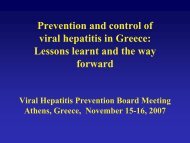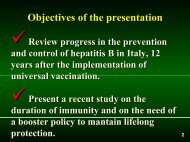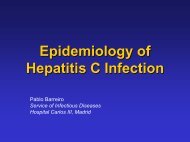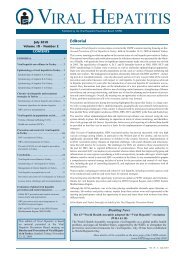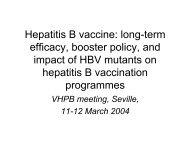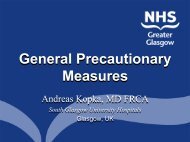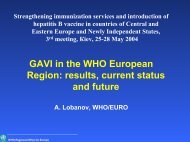HBs antibodies <strong>in</strong> protective titers were detected by EIA <strong>and</strong> RIA techniques <strong>in</strong> 76.7% <strong>of</strong> childrenaged 4-5 months after the 3rd <strong>in</strong>jection, <strong>in</strong> 95.7% <strong>of</strong> children aged 15-16 months <strong>and</strong> <strong>in</strong> 90.0% <strong>of</strong>children aged 2-2.5 years after the 4 th (booster) <strong>in</strong>jection. In the <strong>control</strong> group (117 nonimmunizedchildren born <strong>of</strong> HBs carriers) observed dur<strong>in</strong>g the same period anti-HBs antibodies were detectedsignificantly less frequently (<strong>in</strong> 7.3%, 11.6% <strong>and</strong> 12.9% <strong>of</strong> these children respectively). 1-2months after the course <strong>of</strong> immunization was completed 74.1% <strong>of</strong> the immunized children hadhigh anti-HBs antibody titers (exceed<strong>in</strong>g 1000 IU/ml) with their subsequent decrease by 2-2.5years <strong>of</strong> age. In the <strong>control</strong> group these figures were 27.1% <strong>and</strong> 29.0% respectively. The <strong>in</strong>dex <strong>of</strong>immunization effectiveness obta<strong>in</strong>ed by the comparison <strong>of</strong> the <strong>hepatitis</strong> B morbidity rates <strong>in</strong> bothgroups was 7.8. No postvacc<strong>in</strong>al complications were registered.Kondili LA, Brunetto MR, Ma<strong>in</strong>a AM, Argent<strong>in</strong>i C, Chionne P, La Sorsa V, Resuli B, MeleA, Rapicetta M. Cl<strong>in</strong>ical <strong>and</strong> molecular characterization <strong>of</strong> chronic <strong>hepatitis</strong> B <strong>in</strong> Albania: acountry that is still highly endemic for HBV <strong>in</strong>fection. J Med Virol 2005; 75:20-26.Department <strong>of</strong> Infectious, Parasitic, <strong>and</strong> Immunomediated Diseases, Viral Hepatitis Unit, IstitutoSuperiore di Sanità, Viale Reg<strong>in</strong>a Elena 299, 00161 Rome, Italy.Albania is a Mediterranean country, still with a high endemicity level <strong>of</strong> <strong>hepatitis</strong> B <strong>virus</strong> (HBV)<strong>in</strong>fection. The chronic <strong>hepatitis</strong> B pr<strong>of</strong>ile was characterized <strong>in</strong> this geographical area <strong>and</strong> used as amodel to <strong>in</strong>vestigate the impact <strong>of</strong> endemicity level on the prevalence <strong>of</strong> the two major forms <strong>of</strong>chronic <strong>hepatitis</strong> B (HBeAg-positive <strong>and</strong> HBeAg-negative chronic <strong>hepatitis</strong> B). A cross-sectionalstudy was conducted among 62 chronic <strong>hepatitis</strong> B patients consecutively admitted to the mostimportant tertiary health care center for the diagnosis <strong>and</strong> treatment <strong>of</strong> liver disease <strong>in</strong> Albania.HBV-DNA was measured with an <strong>in</strong>-house PCR with a sensitivity <strong>of</strong> 10 4 copies/ml which usesprimers encompass<strong>in</strong>g the pre-core/core region. PCR products were subjected to sequenc<strong>in</strong>g <strong>and</strong>oligohybridization assay. Of the 62 patients, 75.8% had HBeAg-negative chronic <strong>hepatitis</strong> B.Genotype D was found <strong>in</strong> all 39 patients with detectable HBV viremia, for whom theheterogeneity <strong>of</strong> the region modulat<strong>in</strong>g HBeAg expression was assessed. Basic core promoter(BCP) mutations (1762/1764) were observed more <strong>of</strong>ten <strong>in</strong> anti-HBe-positive <strong>and</strong> older patients.In more than 90% <strong>of</strong> the HBeAg-negative chronic <strong>hepatitis</strong> B patients with detectable viremia,HBV that carries the G to A pre-core mutation at nucleotide 1896 was found. Patients withHBeAg-positive chronic <strong>hepatitis</strong> B were younger than HBeAg-negative chronic <strong>hepatitis</strong> Bpatients, <strong>and</strong> for symptomatic <strong>and</strong> asymptomatic liver-disease patients, the age <strong>of</strong> peak prevalencewas at least 10 years lower for HBeAg-positive chronic <strong>hepatitis</strong> B patients. In conclusion, thevirological <strong>and</strong> cl<strong>in</strong>ical pattern <strong>of</strong> chronic <strong>hepatitis</strong> B <strong>in</strong> Albania is similar to that observed <strong>in</strong> otherMediterranean countries; it seems to be <strong>in</strong>dependent <strong>of</strong> the HBV endemicity level.Koyama T, Matsuda I, Sato S, Yoshizawa H. <strong>Prevention</strong> <strong>of</strong> <strong>per<strong>in</strong>atal</strong> <strong>hepatitis</strong> B <strong>virus</strong><strong>transmission</strong> by comb<strong>in</strong>ed passive-active immunoprophylaxis <strong>in</strong> Iwate, Japan (1981-1992) <strong>and</strong>epidemiological evidence for its efficacy. Hepatol Res 2003; 26:287-292.Health Service Association, Iwate, JapanIn a model area <strong>in</strong> Iwate, Japan, with a population <strong>of</strong> 1.4 million, the immunoprophylaxis <strong>of</strong><strong>per<strong>in</strong>atal</strong> <strong>transmission</strong> <strong>of</strong> <strong>hepatitis</strong> B <strong>virus</strong> (HBV) was started <strong>in</strong> 1981 <strong>and</strong> covered > 60% <strong>of</strong> allbirths already <strong>in</strong> 1986 when it became m<strong>and</strong>atory by the national program. Babies born to motherswho carried <strong>hepatitis</strong> B surface antigen (HBsAg) along with <strong>hepatitis</strong> B e antigen (HBeAg) <strong>in</strong>serum received <strong>hepatitis</strong> B immune globul<strong>in</strong> (HBIg) at birth <strong>and</strong> 2 months as well as vacc<strong>in</strong>e at 2,3 <strong>and</strong> 5 months after birth. In 1985, 39 <strong>of</strong> 45 (86.7%) babies who received immunoprophylaxis didnot develop the HBV carrier state. Dur<strong>in</strong>g 1986-1992, 100286 <strong>of</strong> 104493 (96.0%) expect<strong>in</strong>gmothers received tests for HBsAg, <strong>and</strong> it was detected <strong>in</strong> 1242 (1.2%) <strong>of</strong> them. Among themothers carry<strong>in</strong>g HBsAg, 257 (20.7%) were positive for HBeAg <strong>and</strong> their babies received22
immunoprophylaxis. Reflect<strong>in</strong>g effects <strong>of</strong> immunoprophylaxis, the prevalence <strong>of</strong> HBsAgdecreased from 0.75% (78/10437) <strong>in</strong> the children born dur<strong>in</strong>g 1978-1980 to 0.23% (46/20812) <strong>in</strong>those dur<strong>in</strong>g 1981-1985 (P < 0.001), <strong>and</strong> further to 0.04% (12/32049) <strong>in</strong> those dur<strong>in</strong>g 1986-1990(P < 0.001). The prevalence rates <strong>of</strong> antibody to HBsAg (anti-HBs) were 1.52, 0.79 <strong>and</strong> 0.85% <strong>in</strong>the three groups <strong>of</strong> children (P < 0.001 between those dur<strong>in</strong>g 1978-1980 <strong>and</strong> the others). Thefrequency <strong>of</strong> antibody to HBV core <strong>in</strong> the children with anti-HBs dim<strong>in</strong>ished remarkably from76.7% (23/30) <strong>in</strong> those born <strong>in</strong> 1971 to 9.0% (6/67) <strong>in</strong> those born <strong>in</strong> 1990, thereby <strong>in</strong>dicat<strong>in</strong>g amarked decrease <strong>in</strong> resolved <strong>in</strong>fection <strong>and</strong> <strong>in</strong>crease <strong>in</strong> acquired immunity to HBV as the results <strong>of</strong>immunoprophylaxis.Kuru U, Turan O, Kuru N, Saglam Z, Ceylan Y, Nurluoğlu M, Agacfidan A. Prevalence <strong>of</strong><strong>hepatitis</strong> B <strong>virus</strong> <strong>in</strong>fection <strong>in</strong> pregnant Turkish women <strong>and</strong> their families. Eur J Cl<strong>in</strong> MicrobiolInfect Dis 1996; 15:248-251.Department <strong>of</strong> Pediatrics, Bakirkoy Maternity <strong>and</strong> Children's Hospital, Social InsuranceFoundation, Bakirkoy, Istanbul, Turkey.A total <strong>of</strong> 5,366 pregnant Turkish women were screened for <strong>hepatitis</strong> B surface antigen (HBsAg)<strong>and</strong> 225 (4.2%) <strong>of</strong> them were found to be positive. Hepatitis B e antigen (HBeAg) was detected <strong>in</strong>6.2% <strong>of</strong> HBsAg-positive pregnant women. the overall prevalence <strong>of</strong> HBsAg <strong>and</strong> antibody toHBsAg (anti-HBs) among the spouses, previous children, mothers <strong>and</strong> first degree relatives <strong>of</strong> theHBsAg-positive pregnant women was 56%, 49%, 79% <strong>and</strong> 74% respectively. The prevalence <strong>of</strong>HBsAg is thus high <strong>in</strong> pregnant Turkish women with familial cluster<strong>in</strong>g <strong>of</strong> <strong>hepatitis</strong> B <strong>virus</strong><strong>in</strong>fection.Kuz<strong>in</strong> SN, Ikoev VN, Shakhgil'dian IV, Gorbunov MA, Farber NA, Mikhailov MI,Brag<strong>in</strong>skii DM, Karetnyi IuV, Buriev AIa, Khalitova KA, et al. Patterns <strong>in</strong> <strong>per<strong>in</strong>atal</strong> <strong>in</strong>fectionwith the <strong>hepatitis</strong> B <strong>virus</strong> <strong>in</strong> areas contrasted by the level <strong>of</strong> HBsAg <strong>and</strong> HBeAg carriage. VoprVirusol 1990; 35:304-306. [Article <strong>in</strong> Russian]In 1984-1988, the levels <strong>of</strong> HBsAg carrier state <strong>and</strong> the status <strong>of</strong> the ‘e’-system components <strong>in</strong>pregnant women <strong>in</strong> Moscow <strong>and</strong> <strong>in</strong> the Uzbek SSR, as well as the rate <strong>of</strong> <strong>in</strong>fection with <strong>hepatitis</strong> B<strong>virus</strong> (HBV) <strong>in</strong> babies born to women carriers <strong>of</strong> HBsAg <strong>in</strong> regions with different levels <strong>of</strong> HBsAg<strong>and</strong> HBeAg carrier state were studied. The levels <strong>of</strong> HBsAg carrier state among pregnant womenwere different <strong>in</strong> Moscow <strong>and</strong> Uzbekistan (1.1% <strong>and</strong> 6.9%, respectively). It was noted that <strong>in</strong>female HBsAg carriers <strong>in</strong> these regions the rate <strong>of</strong> HBeAg detection differed greatly: 5.2% <strong>in</strong>Moscow <strong>and</strong> 13.9% <strong>in</strong> Uzbekistan. The frequency <strong>of</strong> <strong>per<strong>in</strong>atal</strong> <strong>in</strong>fection with HBV <strong>in</strong> Moscow was26.1%, <strong>in</strong> Uzbekistan 40.0%, the frequency <strong>of</strong> persistent carrier state <strong>of</strong> HBsAg <strong>in</strong> the <strong>in</strong>fectedbabies <strong>of</strong> Uzbekistan was 16.0%. The possibility <strong>of</strong> formation <strong>of</strong> HBsAg persistence <strong>in</strong> babiesborn to women with HBsAg <strong>and</strong> anti-HBe <strong>in</strong> the blood was demonstrated. The problem <strong>of</strong> the use<strong>of</strong> specific prophylaxis measures to prevent <strong>per<strong>in</strong>atal</strong> <strong>transmission</strong> <strong>of</strong> HBV is discussed.Lazizi Y, Badur S, Perk Y, Ilter O, Pillot J. Selective unresponsiveness to HBsAg vacc<strong>in</strong>e <strong>in</strong>newborns related with an <strong>in</strong> utero passage <strong>of</strong> <strong>hepatitis</strong> B <strong>virus</strong> DNA. Vacc<strong>in</strong>e 1997; 15:1095-1100.Unité d'Immunologie Microbienne, Hôpital Anto<strong>in</strong>e Béclère, WHO Center <strong>of</strong> Reference <strong>and</strong>Research for Viral Hepatitis, Clamart, France.Thirty four out <strong>of</strong> 158 (22%) newborns to mothers chronically <strong>in</strong>fected by the <strong>hepatitis</strong> B <strong>virus</strong>(HBV) did not produce antibodies (Ab) to HBsAg 1 month after the last <strong>in</strong>jection <strong>of</strong> the HBVvacc<strong>in</strong>e supplemented with HBV specific immunoglobul<strong>in</strong>s. At birth, HBV genome was detectedby polymerase cha<strong>in</strong> reaction (PCR) <strong>in</strong> the peripheral blood mononuclear cells (PBMC) <strong>of</strong> a large23
- Page 1 and 2: Pre-meeting documentPrevention and
- Page 3 and 4: Part I Prevention and control of pe
- Page 5 and 6: prevalence was significantly higher
- Page 7 and 8: clusters (obstetrics wards/hospital
- Page 9 and 10: Boxall E. Screening of pregnant wom
- Page 11 and 12: Chang MH, Hsu HY, Huang LM, Lee PI,
- Page 13 and 14: of infection in infants and childre
- Page 15 and 16: Eriksen EM, Perlman JA, Miller A, M
- Page 17 and 18: liver enzyme abnormalities than wer
- Page 19 and 20: health care, is feasible and achiev
- Page 21: HBsAg and anti-HBs in 4.5%. In the
- Page 25 and 26: Levin CE, Nelson CM, Widjaya A, Mon
- Page 27 and 28: Delaying vaccination of premature i
- Page 29 and 30: diagnosis. In the past, the inciden
- Page 31 and 32: shows that the prevalence of HBV in
- Page 33 and 34: Niu MT, Targonski PV, Stoll BJ, Alb
- Page 35 and 36: Ranger-Rogez S, Alain S, Denis F. H
- Page 37 and 38: vaccinees) and low reactogenicity o
- Page 39 and 40: single ELISA test is about Rs40. At
- Page 41 and 42: newborns with surface antigenemia,
- Page 43 and 44: Wang Z, Zhang J, Yang H, Li X, Wen
- Page 45 and 46: of hepatitis B vaccine. This study
- Page 47 and 48: transmission has been estimated at
- Page 49 and 50: at birth and 2 weeks after birth, f
- Page 51 and 52: Chubinishvili OV, Mikhailov MI, Sak
- Page 53 and 54: Jensen L, Heilmann C, Smith E, Want
- Page 55 and 56: Onishchenko GG. Incidence of infect
- Page 57: Zanetti A, Tanzi E, Semprini AE. He


